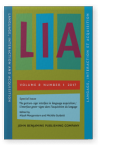Baggio, Guido
2023.
Gesture, meaning, and intentionality: from radical to pragmatist enactive theory of language.
Phenomenology and the Cognitive Sciences 
Rinaldi, Pasquale, Patrizio Pasqualetti, Virginia Volterra & Maria Cristina Caselli
2023.
Gender differences in early stages of language development. Some evidence and possible explanations.
Journal of Neuroscience Research 101:5
► pp. 643 ff.

Wille, Beatrijs, Hilde Nyffels & Olga Capirci
Capirci, Olga, Morgana Proietti & Virginia Volterra
Rinaldi, Pasquale, Arianna Bello, Francesca Romana Lasorsa & Maria Cristina Caselli
2022.
Do Spoken Vocabulary and Gestural Production Distinguish Children with Transient Language Delay from Children Who Will Show Developmental Language Disorder? A Pilot Study.
International Journal of Environmental Research and Public Health 19:7
► pp. 3822 ff.

Rodríguez, Fernando G. & Silvia Español
2022.
The Transition from Early Bimodal Gesture-Word Combinations to Grammatical Speech. In
Moving and Interacting in Infancy and Early Childhood,
► pp. 207 ff.

Sparaci, Laura, Domenico Formica, Francesca Romana Lasorsa, Luigi Raiano, Paola Venuti & Olga Capirci
2022.
New Methods for Unraveling Imitation Accuracy Differences Between Children with Autism and Typically Developing Peers.
Perceptual and Motor Skills 129:6
► pp. 1749 ff.

Stewart, Jessica R., Ruth Crutchfield & Wan-Lin Chang
2022.
Prelinguistic gesture and developmental abilities: A multi-ethnic comparative study.
Infant Behavior and Development 68
► pp. 101748 ff.

Lasorsa, Francesca Romana, Maria Cristina Caselli, Ilaria Simonelli, Silvia Stefanini, Patrizio Pasqualetti & Pasquale Rinaldi
2021.
Exploring Agreement between MB-CDI Short Forms for Evaluating the Language Skills of Italian Children Aged 18–24 Months.
Folia Phoniatrica et Logopaedica 73:6
► pp. 552 ff.

Bello, Arianna, Silvia Stefanini, Pasquale Rinaldi, Daniela Onofrio & Virginia Volterra
Capobianco, Micaela & Luca Cerniglia
2020.
Coarticolazione temporale nelle combinazioni di gesti e parole: dati longitudinali in bambini nati a termine e pretermine nei primi due anni di età.
RICERCHE DI PSICOLOGIA :2
► pp. 547 ff.

Lüke, Carina, Ute Ritterfeld, Angela Grimminger, Katharina J. Rohlfing & Ulf Liszkowski
2020.
Integrated Communication System: Gesture and Language Acquisition in Typically Developing Children and Children With LD and DLD.
Frontiers in Psychology 11

Tomasuolo, Elena, Chiara Bonsignori, Pasquale Rinaldi & Virginia Volterra
2020.
The representation of action in Italian Sign Language (LIS).
Cognitive Linguistics 31:1
► pp. 1 ff.

Adami, Elisabetta & Ruth Swanwick
2019.
Signs of understanding and turns-as-actions: a multimodal analysis of deaf–hearing interaction.
Visual Communication ► pp. 147035721985477 ff.

Cattani, Allegra, Caroline Floccia, Evan Kidd, Paola Pettenati, Daniela Onofrio & Virginia Volterra
2019.
Gestures and Words in Naming: Evidence From Crosslinguistic and Crosscultural Comparison.
Language Learning 69:3
► pp. 709 ff.

Humphries, Tom, Poorna Kushalnagar, Gaurav Mathur, Donna Jo Napoli, Christian Rathmann & Scott Smith
2019.
Support for parents of deaf children: Common questions and informed, evidence-based answers.
International Journal of Pediatric Otorhinolaryngology 118
► pp. 134 ff.

Salo, Virginia C., Pier F. Ferrari & Nathan A. Fox
2019.
The role of the motor system in action understanding and communication: Evidence from human infants and non‐human primates.
Developmental Psychobiology 61:3
► pp. 390 ff.

Sansavini, Alessandra, Annalisa Guarini, Mariagrazia Zuccarini, Jessica Zong Lee, Giacomo Faldella & Jana Marie Iverson
2019.
Low Rates of Pointing in 18-Month-Olds at Risk for Autism Spectrum Disorder and Extremely Preterm Infants: A Common Index of Language Delay?.
Frontiers in Psychology 10

Fibigerova, Katerina, Jean-Marc Colletta & Michèle Guidetti
Fibigerova, Katerina, Jean-Marc Colletta & Michèle Guidetti
Volterra, Virginia, Olga Capirci, Pasquale Rinaldi & Laura Sparaci
Volterra, Virginia, Olga Capirci, Pasquale Rinaldi & Laura Sparaci
Zuccarini, Mariagrazia, Annalisa Guarini, Jana Marie Iverson, Erika Benassi, Silvia Savini, Rosina Alessandroni, Giacomo Faldella & Alessandra Sansavini
2018.
Does early object exploration support gesture and language development in extremely preterm infants and full-term infants?.
Journal of Communication Disorders 76
► pp. 91 ff.

Sparaci, Laura & Virginia Volterra
2017.
Hands Shaping Communication: From Gestures to Signs. In
The Hand [
Studies in Applied Philosophy, Epistemology and Rational Ethics, 38],
► pp. 29 ff.

This list is based on CrossRef data as of 5 july 2024. Please note that it may not be complete. Sources presented here have been supplied by the respective publishers.
Any errors therein should be reported to them.
